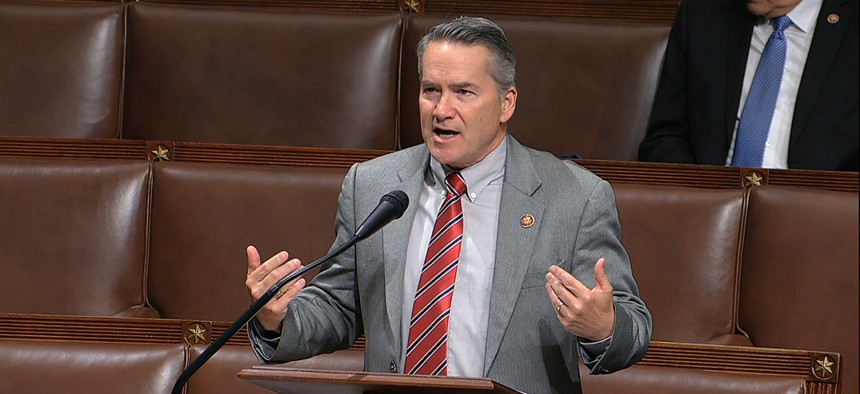Republicans Press Biden to Bring Federal Employees Back to Their Offices Immediately
The administration has so far maintained its governmentwide 25% maximum capacity policy for federal buildings.
Congressional Republicans are pressuring the Biden administration to quickly bring all federal employees back to their offices, saying the COVID-19 pandemic has abated sufficiently to no longer require large swaths of workers to remain at home.
The most recent such request, sent by Rep. Jody Hice, R-Ga., to Office of Personnel Management acting Director Kathleen McGettigan, followed an advisory from the White House this week that “maximum telework” remained in effect across government. The administration has yet to lift its 25%-of-capacity maximum for federal buildings, saying only it would issue updates “based on public health guidance.”
Hice called on OPM to return employees to their normal duty stations “immediately,” citing growing vaccinations and shrinking active case totals.
“COVID-19 cases are plummeting across the country and it’s past time for the federal workforce to return to their places of work,” said Hice, the top Republican on the House Oversight and Government Reform Committee’s panel with oversight of federal employees. “Prolonged remote work is harming Americans’ access to federal agencies and is costing taxpayers.”
Like millions of workers across the country, much of the federal workforce has worked remotely since March 2020, including about 60% during the pandemic's peak. Select agencies have begun recalling employees on a scattershot basis, due to evolving mission needs and other factors. Many federal employees have worked from their normal sites throughout the pandemic as the nature of their jobs did not allow them to go remote.
Hice suggested, as an example, the Internal Revenue Service is providing insufficient customer service to taxpayers, even though the agency has recalled thousands of workers. He also pointed an inspector general’s findings that the Defense Department has experienced shortcomings with its network capacity. Hice requested a briefing from OPM later this month to discuss the “preparation and planning underway” to return federal workers to their normal locations.
President Biden has established a task force, led by OPM and the General Services Administration, to determine policy changes related to the federal workforce and the pandemic. Agency leaders must work with the task force before any office can exceed the current 25% capacity limit. In a separate letter sent earlier this month, Rep. Mike Waltz, R-Fla., asked McGettigan and Office of Management and Budget acting Director Shalanda Young why federal offices in states with low transmission cannot open, how reopening decisions are being made and what agencies are doing to ensure they can recall their workers as quickly as possible.
The letters from Hice and Waltz followed a similar one by Sen. Josh Hawley, R-Mo., who said constituents had complained about absences at the Social Security Administration and National Archives and Records Administration.
“My constituents should have access to basic government services,” Hawley said in his own letter to McGettigan and Young. “If these services are not adequately provided remotely, then it’s incumbent upon you and agency leadership to find another solution. Remote work cannot become a permanent reality for the field offices that need to interact with Missourians every day.”
Hawley noted that federal employees have worked under “extraordinary circumstances” in the last year, but said Congress had provided funding to agencies to help them return to normal and “the time has come” to do so. Hice suggested that if agencies were to make some parts of their workforces remote indefinitely, lawmakers should consider restructuring employees’ eligibility for locality pay.
An administration official said the White House will bring back its own employees later this summer, but would not comment on when such guidance would be issued for the federal workforce writ large. Isabel Aldunate, an OMB spokeswoman, said the Safer Federal Workforce task force is meeting multiple times per week and analyzing a variety of metrics, but said it does not have a timeline for updating the 25% capacity maximum. Some administration officials have speculated the government will never return to the pre-pandemic state of affairs, when just 3% of feds teleworked on a daily basis.
“There’s a wealth of research over the last decades that show all kinds of positive effects gained through telework," OPM acting Director of Strategy and Innovation Kimberly Wells said last month after the most recent Federal Employee Viewpoint Survey found strong correlation between employee engagement and remote work, "and I know these discussions are being had across agencies to see how we can capture this boon to performance through engaging more telework.”








